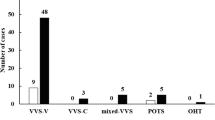Abstract
Unexplained syncope may cause diagnostic and therapeutic problems in children. The head-up tilt test has been shown to be a useful tool for investigating unexplained syncope, especially for diagnosis of neurally mediated syncope. In this study 20 patients aged 9–18 years (12.0±2.5 years) with syncope of unknown origin and 10 healthy age-matched children were evaluated by head-up tilt to 60° for 25 minutes. The test was considered positive if syncope or presyncope developed in association with hypotension, bradycardia, or both. If tilting alone did not induce symptoms (syncope or presyncope), isoproterenol infusion was administered with increasing doses (0.02–0.08 μg/kg per minute). During the tilt test, symptoms were elicited in 15 (75%) of the patients with unexplained syncope but in only one (10%) of the control group (p<0.001). The sensitivity of the test was 75% and its specificity 90%. Three patterns of response to upright tilt were observed in symptomatic patients: vasodepressor pattern with an abrupt fall in blood pressure in 67%; cardioinhibitory pattern with profound bradycardia in 6%; and mixed pattern in 27%. In patients with positive head-up tilt, there were sudden decreases in systolic blood pressure (from 130±15 to 61±33 mmHg) and in mean heart rate (from 147±26 to 90±38 beats per minute) (p<0.001) during symptoms. Treatments with atenolol 25 mg/day has shown complete suppression of syncope in positive responders during a mean follow-up period of 18±6 months. The head-up tilt test is a noninvasive, sensitive, specific diagnostic tool for evaluating children with unexplained syncope.
Similar content being viewed by others
References
Abboud FM (1989) Ventricular syncope: is the heart a sensory organs?N Engl J Med 320:390–392 [editorial]
Abi-Samra F, Maloney JD, Fouad FM, Castle LW (1988) The usefulness of head-up tilt testing and haemodynamic investigation in the workup of syncope of unknown origin.PACE 11:1202–1214
Almquist A, Goldenberg IF, Milstein S, et al (1989) Provocation of bradycardia and hypotension by isoproterenol and upright posture in patients with unexplained syncope.N Engl J Med 320:346–351
Benditt DG, Remole S, Bailin S, et al (1991) Tilt table testing for evaluation of neurally-mediated (cardioneurogenic) syncope: rationale and proposed protocols.PACE 14:1528–1537
Chen MY, Goldenberg IF, Milstein S, et al (1989) Cardiac electrophysiologic and hemodynamic correlates of neurally mediated syncope.Am J Cardiol 63:66–72
Fish FA, Strasburger JF, Benson DW Jr (1992) Reproducibility of a symptomatic response to upright tilt in young patients with unexplained syncope.Am J Cardiol 70:605–609
Fitzpatrick A, Sutton R (1989) Tilting towards a diagnosis in recurrent unexplained syncope.Lancet 1:658–660
Fouad FM, Sitthisook S, Vanerio G, et al (1993) Sensitivity and specificity of the tilt table test in young patients with unexplained syncope.PACE 16:394–400
Grubb BP, Armos PT, Hahn H, Elliot I (1991) Utility of upright tilt-table testing in the evaluation and management of syncope of unknown origin.Am J Med 90:6–10
Kapoor WN (1991) Diagnostic evaluation of syncope.Am J Cardiol 90:91–106
Kenny RA, Ingram A, Bayliss J, Sutton R (1986) Head-up tilt: a useful test for investigating unexplained syncope.Lancet 1:1352–1355
Lerman-Sagie T, Rechavia E, Strasberg B, et al (1991) Head-up tilt for the evaluation of syncope of unknown origin in children.J Pediatr 118:676–679
Manolis AS, Linzer M, Salem D, Estas NAM (1990) Syncope: current diagnostic evaluation and management.Ann Intern Med 112:850–863
Mark AL (1983) The Bezold-Jarisch reflex revisited: clinical implications of inhibitory reflexes originating in the heart.J Am Coll Cardiol 1:90–102
Milstein S, Buetikofer J, Dunnigon A, et al (1990) Usefulness of disopyramide for prevention of upright tilt-induced hypotension-bradycardia.Am J Cardiol 65:1339–1344
Müller G, Deal BJ, Strasburger JF, Benson DW Jr (1993) Usefulness of metoprolol for unexplained syncope and positive response to tilt testing in young persons.Am J Cardiol 71:592–595
Özme Ş, Alehan D, Yalaz K, et al (1993) Causes of syncope in children: a prospective study.Int J Cardiol 40:111–114
Pongiglione G, Fish FA, Strasburger JF, Benson DW Jr (1990) Heart rate and blood pressure response to upright tilt in young patients with unexplained syncope.J Am Coll Cardiol 16:165–170
Raviele A, Gasparini G, Pede FD, et al (1990) Usefulness of head-up tilt in evaluating patients with syncope of unknown origin and negative electrophysiologic study.Am J Cardiol 65:1322–1327
Rea RF (1989) Neurally mediated hypotension and bradycardia: which nerves? how mediated?J Am Coll Cardiol 14:1633–1634 [editorial]
Ross BA, Hughes S, Anderson E, Gillette PC (1991) Abnormal responses to orthostatic testing in children and adolescents with recurrent unexplained syncope.Am Heart J 122:748–754
Scherrer U, Vissling S, Morgan BJ, Hanson P, Victor RG (1990) Vasovagal syncope after infusion of a vasodilator in a heart transplant recipient.N Engl J Med 322:602–604.
Shalev Y, Gal R, Tchou PJ, et al (1991) Echocardiographic demonstration of decreased left ventricular dimensions and vigorous myocardial contraction during syncope induced by head-up tilt.J Am Coll Cardiol 18:746–751
Sutton R, Vardas P, Ingram A, et al (1988) Value of tilt testing in unexplained syncope.PACE 11:508–511
Thilenius OG, Quinones JA, Husayni TS, Novak J (1991) Tilt test for diagnosis of unexplained syncope in pediatric patients.Pediatrics 87:334–338
Waxmann MB, Yao L, Cameron DA, Wald RW, Rosemann J (1989) Isoproterenol induction of vasodepressor-type reaction in vasodepressor-prone persons.Am J Cardiol 63:58–65
Author information
Authors and Affiliations
Rights and permissions
About this article
Cite this article
Alehan, D., Çeliker, A. & Özme, Ş. Head-up tilt test: A highly sensitive, specific test for children with unexplained syncope. Pediatr Cardiol 17, 86–90 (1996). https://doi.org/10.1007/BF02505089
Issue Date:
DOI: https://doi.org/10.1007/BF02505089




